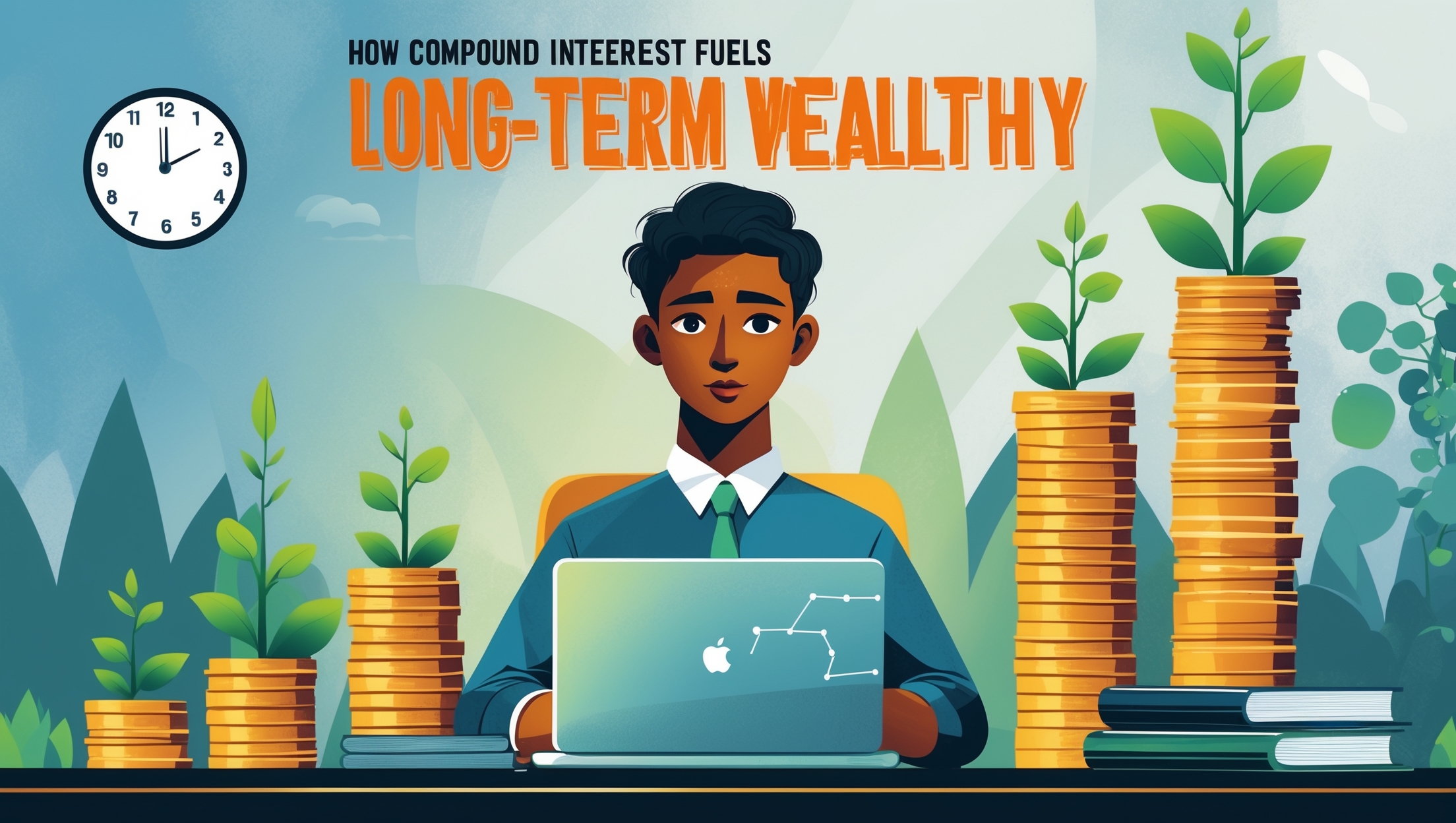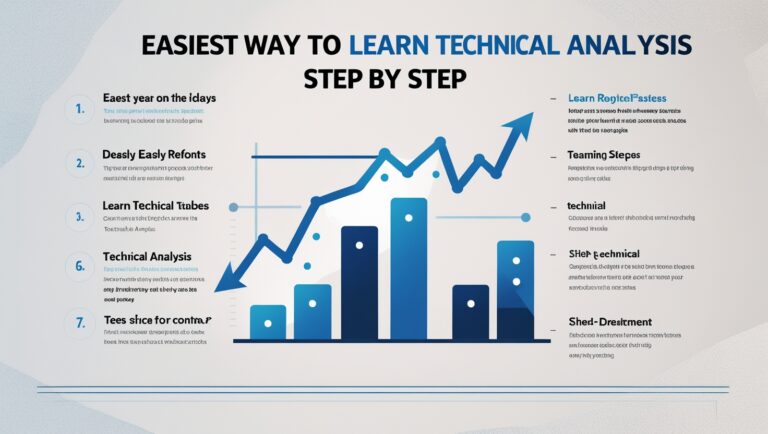How Compound Interest Fuels Long-Term Wealth
How Compound Interest Fuels Long-Term Wealth
Discover how compound interest can accelerate your wealth over time, why starting early matters, and how I personally use compounding strategies to grow my investments. Learn actionable steps to maximize long-term returns.

Table of Contents
What Is Compound Interest?
Compound interest is the process where your investment earnings generate additional earnings over time. Essentially, you earn interest on your initial investment and on the interest it accumulates.
I first experienced the power of compounding when I reinvested dividends from my stocks. Over time, the reinvested amounts grew exponentially, showing me that time and consistency are more powerful than high returns alone.
Even small contributions can grow significantly if left to compound over the years. This is why I always emphasize starting early and staying invested.
Why Starting Early Makes a Difference
I learned that the earlier I start investing, the greater the effect of compounding. A $1,000 investment can grow dramatically over decades, even with moderate returns.
By starting early, I give my money time to work for me, and the compounding effect accelerates growth as my portfolio expands. This has been a cornerstone of my long-term wealth strategy.
How I Use Compounding in My Portfolio
I focus on reinvesting dividends and capital gains. Every time I receive a payout, I immediately reinvest it, which increases my total invested amount and amplifies growth.
I also contribute consistently. Automated monthly contributions to ETFs, mutual funds, and dividend stocks ensure that compounding continues uninterrupted.
By staying invested through market ups and downs, I maximize the compounding effect rather than trying to time the market.
The Role of Patience
Patience is critical. Compounding doesn’t produce overnight results. I’ve learned that resisting the urge for quick gains allows long-term wealth to build steadily.
The most significant growth in my portfolio often occurs years after initial investments, highlighting that time is one of the most powerful components of compounding.
Compounding Across Asset Classes
I apply compounding across stocks, ETFs, mutual funds, and even bonds. By diversifying my investments, I allow multiple streams to grow simultaneously, enhancing the overall effect.
Dividend-paying stocks and ETFs have been particularly effective. By reinvesting dividends, I turn passive income into additional growth, further leveraging the power of compounding.
Tax-Efficient Compounding
I’ve learned to use tax-advantaged accounts like IRAs and Roth IRAs to maximize compounding without the drag of taxes. Tax efficiency can significantly accelerate wealth accumulation over decades.
Even in taxable accounts, I prioritize low-turnover ETFs to minimize capital gains distributions, ensuring compounding remains strong.
Common Mistakes I Avoid
I’ve seen investors sabotage compounding by:
- Withdrawing earnings early, interrupting growth
- Switching investments too frequently, which can generate fees and taxes
- Focusing only on high returns instead of consistency
By avoiding these pitfalls, I let compounding work fully and steadily over time.
Tools and Automation I Use
I use automated investing platforms and recurring contributions to ensure I don’t miss opportunities for compounding. Even when I’m busy, my portfolio continues to grow through reinvested dividends and interest.
Automation also helps me stay disciplined, reducing the temptation to withdraw funds for short-term desires.
Real-Life Example
For instance, I invested $5,000 in a diversified ETF portfolio and reinvested dividends over 20 years. Even at a modest 7% annual return, compounding turned that $5,000 into more than $20,000, illustrating the exponential growth potential.
This experience reinforced that consistent contributions and reinvestment matter more than chasing high-risk returns.
How I Integrate Compounding Into My Wealth Plan
I combine compounding with diversification, rebalancing, and risk management. By keeping allocations aligned with goals and reinvesting earnings, I maintain steady growth over time.
I also use compounding to fund multiple objectives, such as retirement, emergency funds, and side income streams, all growing simultaneously.
Want My Full Compounding Strategy?
If you want to see exactly how I leverage compound interest to grow wealth, reinvest dividends, and automate investments, I share my full system in my ebook: Pay Bills with Stocks.
I explain step by step how to combine compounding with ETFs, mutual funds, dividend stocks, and automation to maximize long-term growth.
Final Thoughts
Compound interest is one of the most powerful tools in wealth building. By starting early, contributing consistently, and reinvesting earnings, I’ve been able to grow my portfolio steadily and confidently.
For a detailed guide on using compounding effectively in your own investment strategy, check out my ebook: Pay Bills with Stocks.
One of the first things I realized is that consistency matters more than large sums. Even small contributions, made regularly, can grow substantially over decades through compounding.
I set up automatic monthly contributions to my investment accounts. This ensures I don’t miss out on opportunities for compounding, even when life gets busy.
Reinvesting dividends has been a game-changer. By putting dividend payouts back into the same stocks or ETFs, I’ve turned passive income into additional growth, which accelerates compounding over time.
I also prioritize long-term investments. By staying invested through market fluctuations, I allow compounding to work uninterrupted, which produces exponential growth in my portfolio.
Diversification enhances compounding. I spread my investments across stocks, ETFs, mutual funds, and bonds, which allows multiple streams of returns to grow simultaneously.
I’ve noticed that tax efficiency can make a huge difference. Using Roth IRAs and other tax-advantaged accounts, I keep more of my earnings invested and compounding, instead of losing a portion to taxes each year.
Even in taxable accounts, I choose low-turnover ETFs to minimize capital gains distributions, ensuring that compounding continues effectively.
Behavioral discipline is crucial. I avoid withdrawing funds for short-term needs, understanding that even small interruptions can significantly reduce long-term compounding growth.
I also review my investments periodically, making sure that allocations remain aligned with my goals. This prevents overconcentration in one area and keeps compounding on track.
I sometimes use drip investing strategies, automatically reinvesting dividends from multiple assets. This allows me to buy additional shares without thinking, letting compounding work in the background.
Compound interest also benefits from time horizon planning. I prioritize long-term growth accounts for retirement or major life goals, while using shorter-term accounts for liquidity needs.
I’ve learned to ignore market noise. By focusing on steady contributions and reinvesting earnings, I reduce emotional decisions and allow compounding to do its work naturally.
Even modest returns can grow impressively over time. For example, a $2,000 annual contribution at 6–7% returns can turn into six figures in a few decades—a lesson I’ve experienced firsthand.
I integrate compounding into my overall wealth plan, combining it with rebalancing, risk management, and strategic asset allocation. This ensures growth is steady, controlled, and sustainable.
Finally, if you want to see exactly how I use compound interest to build long-term wealth, reinvest dividends, and automate my investments, I share my full system in my ebook: Pay Bills with Stocks. It’s the exact approach I personally use to grow my portfolio consistently and confidently.

Stay ahead in the stock market! Subscribe to our newsletter and receive exclusive stock flow reports, trading insights, and actionable tips directly in your inbox. Join thousands of traders who get our updates first.







